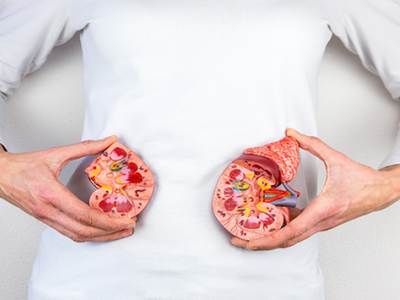
#News UNAIR

Acute Kidney Failure according to UNAIR Nephrologist
- Berita
- /
- 21/12/2022
UNAIR NEWS – The rise of mysterious cases of acute kidney failure in early October has been a hot topic. Approximately 131 children in 14 provinces in Indonesia experienced acute kidney failure, the cause was unknown at that time. The Food and Drug Supervisory Agency (BPOM) then gave a statement that the cause of acute kidney failure in children was due to the consumption of syrup containing chemicals that exceeded the threshold, such as Ethylene Glycol (EG) and Diethylene Glycol (DEG). According to Prof. Djoko Santoso dr. PhD SpPD KGH FINASIM, an Internal Medicine Professor of Universitas Airlangga (UNAIR) and Kidney-Hipertension Consultant, acute kidney failure is a disruption of kidney function that happens fast and suddenly marked by the increase of creatinine serum or decreasing urine production.

Penjelasan Gagal Ginjal Akut Menurut Pakar Nefrologi UNAIR
- Berita
- /
- 18/12/2022
UNAIR NEWS – Maraknya kasus gagal ginjal akut misterius pada awal bulan Oktober lalu masih menjadi pembicaraan hangat. Terdapat kurang lebih 131 anak di 14 provinsi di Indonesia mengalami gagal ginjal akut yang mana saat itu belum diketahui penyebabnya. Badan Pengawas Obat dan Makanan (BPOM) kemudian memberikan pernyataan bahwa penyebab gagal ginjal akut pada anak karena konsumsi obat sirup yang mengandung bahan kimia melebihi ambang batas. Bahan tersebut adalah Etilen Glikol (EG) dan Dietilen Glikol (DEG). Menurut Prof Djoko Santoso dr PhD SpPD KGH FINASIM, guru besar ilmu penyakit dalam Fakultas Kedokteran Universitas Airlangga (UNAIR) dan konsultan ginjal-hipertensi mendefinisikan gagal ginjal akut sebagai kondisi gangguan fungsi ginjal yang muncul dengan serangan mendadak dan cepat ditandai oleh peningkatan serum kreatinin atau menurunnya produksi urin.

A Glimpse on Kidney Stones
- Opini
- /
- 29/07/2022
Almost all of us are familiar with the term kidney stones. The term is very popular and it indicates that the incidence of kidney stones in the community is so high. Several studies report that every year up to half a million people come to the emergency room because of kidney stones. In the United States, it is estimated that one in ten people will have a kidney stone at some point in their life and kidney stones are more common in males. In India, about 12% of people with kidney stones in total population are susceptible to urinary tract stones. Of this 12%, 50% of the population are severely affected by kidney injury, which can even lead to kidney loss. On average, the chances of any of us having at least one kidney stone in our lifetime is about 10%. In developing countries, including Indonesia, the occurrence of stones is increasingly frequent. It is apparent that the incidence of kidney stones is very common.

Mengenal Sekelumit Batu Ginjal
- Opini
- /
- 22/07/2022
Hampir semua dari kita mengenal istilah batu ginjal. Istilah tersebut sangat populer dan itu menandakan bahwa kejadian batu ginjal di tengah masyarakat demikian tingginya. Ada studi yang melaporkan bahwa setiap tahun didapatkan hingga lebih dari setengah juta orang pergi ke ruang gawat darurat karena masalah batu ginjal. Di Amerika, diperkirakan satu dari sepuluh orang akan memiliki batu ginjal pada suatu saat dalam kehidupan mereka dan batu ginjal lebih sering ditemukan pada pria. Sedangkan di India, ditemukan sekitar 12 persen orang dengan batu ginjal pada total populasi yang rentan terhadap batu saluran kemih. Dari 12 persen ini, 50 persen populasi sangat terpengaruh oleh kerusakan ginjal, yang bahkan sampai menyebabkan hilangnya ginjal. Rata-rata, kemungkinan di antara kita setidaknya memiliki satu batu ginjal dalam kehidupan kita adalah sekitar 10 persen. Di negara berkembang termasuk Indonesia, kejadian batu semakin sering. Dari gambaran tersebut, maka jelas nampak bahwa kejadian batu ginjal sangat umum.

What is Contrast-Induced Nephropathy?
- Opini
- /
- 10/07/2022
Have you ever heard of the term contrast-induced nephropathy (CIN)? This term may be unfamiliar for commoners, but this should not be the case for clinicians or health workers. We, especially clinicians and health workers, should be able to prevent contrast-induced nephropathy (CIN), and so we need to know what CIN is or need to recall how CIN occurs. Contrast-Induced Nephropathy is acute injury to kidney tissue caused by the entry of contrast agents into the body through the blood vessels. In normal kidney function, this damage is rare. However, in conditions of impaired kidney function (due to previous kidney disease), this contrast agent can exacerbate existing kidney damage. Contrast agents administered by intravascular injection, apart from having a toxic and apoptotic effect, may cause acute hemodynamic changes in the kidney which is characterized by an increase in renal vascular resistance and a decrease in the glomerular filtration rate.